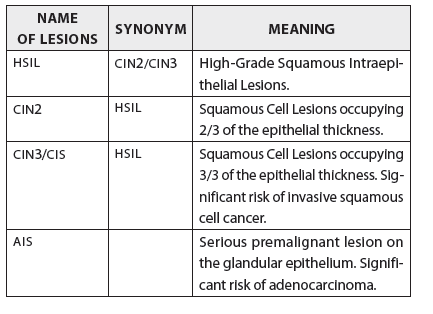
What is the frequency of cervical cancer?
The incidence of cervical cancer varies from country to country.
In countries with organized prevention systems, where women are screened at regular intervals, precancerous lesions are detected and treated. In these countries, the incidence of cervical cancer is relatively low.
Statistical data from the USA show that approximately 11,000-12,000 new cervical cancer cases appear each year, resulting in 4,000-4,500 deaths from the disease. In European countries, around 35,000 new cases are reported each year, resulting in 17,000 women losing their life from the disease.
In developing countries, the incidence of cervical cancer is very high. It is estimated that, across the globe, there are 500,000 new cases every year and 240,000 deaths.
Which types of HPV cause cervical cancer more frequently?
90% of cervical cancer cases are caused by HPV 16, 18, 31 33, 45, 52 and 58. HPV 16 and 18 cause 70% of cancers.
At what age does it usually affect women?
Cervical cancer usually appears in relatively young women. It is the second most frequent cancer in women younger than 44.
Which women are at a higher risk for cervical cancer?
The following parameters increase the risk for cervical cancer:
- Multiple sexual partners, or a partner with a large number of sexual partners in their history (it increases the risk of becoming infected with oncogenic types of HPV).
- Starting sexual activity at a young age (<18 years).
- Personal history of precancerous lesions in the lower reproductive system.
- Smoking.
- History of other sexually transmitted infections (e.g. chlamydia).
- Poor function of the immune system.
- A family history of cervical cancer.
Does cervical cancer develop overnight?
No. It usually takes several years. Precancerous lesions (HSIL/CIN2, 3) appear first and cancer develops later (see figures a-h, pages 160-161).
What are the symptoms of cervical cancer?
Its symptoms may be:
- Vaginal bleeding after intercourse
- Increase of blood quantity during menstruation
- Bloody vaginal discharge
- Odorous vaginal discharge, sometimes with blood traces
- In cases of advanced cervical cancer, there may be: pelvic pain, difficulty urinating, swollen feet, swollen lymph nodes, etc.
How is cervical cancer diagnosis made?
Diagnosis always requires a biopsy.
Once cervical cancer is diagnosed on biopsy, the physician will assess the size of the tumor and the extent of the disease. In addition to the gynecological pelvic examination (Figure 15), we may also perform a rectal digital palpation, CT scan, MRI, cystoscopy, colonoscopy and other tests to find if cancer has spread to other organs.
What is staging?
Staging is applied to all cancers. It is the process of grading the severity of the disease based on its dispersion in the body. The lower the stage, the less advanced the disease.
Stage 0 is the stage of non-invasive carcinoma, also referred to as carcinoma in situ. At this stage, cancer cells are found only inside the epithelium of the cervix. There is no risk of metastasis.
Invasive cervical cancer (as most cancers) is classified in 4 stages (I, II, III, and IV).
Stages of invasive cervical cancer:
- The cancer has spread from the cervix lining (mucosa) into the deeper tissue but is still only found in the cervix. It has not spread to lymph nodes or other parts of the body.
- The cancer has grown beyond the uterus but not to the pelvic wall or to the lower third of the vagina.
- The tumor extends to the pelvic wall, and/or involves the lower third of the vagina, but has not spread to the lymph nodes or other parts of the body.
- The cancer has spread to the bladder or rectum and may or may not have spread to the lymph nodes or other parts of the body.
During the process of grading the severity of the disease your doctor must find:
- Where the tumor is located in the body
- The size of the tumor
- Whether cancer has spread to a different part of the body
- Whether cancer has spread to nearby lymph nodes
- The cell type (such as adenocarcinoma or squamous cell carcinoma)
- Tumor grade, which refers to how abnormal the cancer cells look and how likely the tumor is to grow and spread.
What is metastasis?
In cases with invasive cancer, cancer cells have broken through the basal membrane of the epithelium and have entered deep into the cervical tissue that is full of blood and lymphatic vessels. Blood and lymphatic vessels are eroded by cancer, and cancer cells start, from this point onward, to travel far from their original focus (the cervix) and take residence in other organs of the body,
where they create secondary tumors (metastases).
Cancer spreads in 3 ways.
- Local spreading (cancer spreads to neighboring tissues and organs).
- Spreading through lymphatic vessels, initially to neighboring lymph nodes, and then to other parts of the body and
- Spreading through blood vessels to distant organs (e.g. lungs, bones, liver, etc.).
What are the treatments for cervical cancer?
Treatment depends on the stage of the disease.
There are three treatment methods:
- Radical hysterectomy
- Radiation therapy and
- Chemotherapy
A combination of treatment methods is frequently chosen, in order to achieve the best result.
What is the prognosis for invasive cervical cancer?
As seen in Table, the rates for five-year survival drop for the higher stages of cervical cancer.







